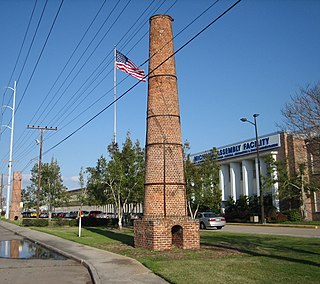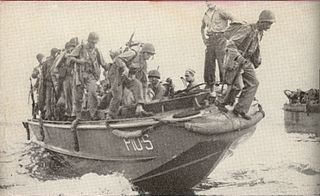
A PT boat was a motor torpedo boat used by the United States Navy in World War II. It was small, fast, and inexpensive to build, valued for its maneuverability and speed but hampered at the beginning of the war by ineffective torpedoes, limited armament, and comparatively fragile construction that limited some of the variants to coastal waters. In the US Navy they were organized in Motor Torpedo Boat Squadrons (MTBRONs).

Landing craft are small and medium seagoing watercraft, such as boats and barges, used to convey a landing force from the sea to the shore during an amphibious assault. The term excludes landing ships, which are larger. Production of landing craft peaked during World War II, with a significant number of different designs produced in large quantities by the United Kingdom and United States.

The Michoud Assembly Facility (MAF) is an 832-acre (337-hectare) industrial complex for the manufacture and structural assembly of aerospace vehicles and components. It is owned by NASA and located in New Orleans East, a section of New Orleans, Louisiana, in the United States. Organizationally it is part of NASA's Marshall Space Flight Center, and is currently a multi-tenant complex to allow commercial and government contractors, as well as government agencies, to use the site.

The landing craft, vehicle, personnel (LCVP) or Higgins boat was a landing craft used extensively by the Allied forces in amphibious landings in World War II. Typically constructed from plywood, this shallow-draft, barge-like boat could ferry a roughly platoon-sized complement of 36 men to shore at 12 knots. Men generally entered the boat by climbing down a cargo net hung from the side of their troop transport; they exited by charging down the boat's lowered bow ramp.

Andrew Jackson Higgins was an American businessman and boatbuilder who founded Higgins Industries, the New Orleans–based manufacturer of "Higgins boats" during World War II. The company started out as a small boat-manufacturing business, and became one of the biggest industries in the world with upwards of eighty thousand workers and government contracts worth nearly three hundred fifty million dollars. General Dwight Eisenhower is quoted as saying, "Andrew Higgins ... is the man who won the war for us. ... If Higgins had not designed and built those LCVPs, we never could have landed over an open beach. The whole strategy of the war would have been different." Adolf Hitler recognized Higgins war efforts in ship production and bitterly dubbed him the "New Noah".

The National WWII Museum, formerly known as The NationalD-Day Museum, is a military history museum located in the Central Business District of New Orleans, Louisiana, U.S., on Andrew Higgins Drive between Camp Street and Magazine Street. The museum focuses on the contribution made by the United States to Allied victory in World War II. Founded in 2000, it was later designated by the U.S. Congress as America's official National WWII Museum in 2004. The museum is a Smithsonian Institution affiliated museum, as part of the Smithsonian Institution's outreach program. The mission statement of the museum emphasizes the American experience in World War II.

The landing craft mechanized (LCM) is a landing craft designed for carrying vehicles. They came to prominence during the Second World War when they were used to land troops or tanks during Allied amphibious assaults.

Michoud is an area in Eastern New Orleans, part of the Ninth Ward of New Orleans, Louisiana, located at latitude 30.03°N, longitude −89.925°W.

The Landing Craft Personnel (Large) or LCP (L) was a landing craft used extensively in the Second World War. Its primary purpose was to ferry troops from transport ships to attack enemy-held shores. The craft derived from a prototype designed by the Eureka Tug-Boat Company of New Orleans, Louisiana, USA. Manufactured initially in boatyards in and around New Orleans, as requirements grew it was produced in a number of yards around the United States. Typically constructed of pine planks and plywood, and fitted with some armor plate, this shallow-draft boat with a crew of 3 could ferry an infantry platoon of 36 to shore at 8 knots (13 km/h). Men generally entered the boat by walking over a gangplank from the boat deck of their troop transport as the LCP(L) hung from its davits. When loaded, the LCP(L) was lowered into the water. Soldiers exited the boat by jumping or climbing down from the craft's bow or sides.

The Curtiss-Wright C-76 Caravan was an American all-wood military transport aircraft. The C-76 was intended as a substitute standard aircraft in the event of expected wartime shortages of light alloys. However, both prototype and production aircraft failed several critical flight and static tests, and after U.S. aluminum production proved sufficient for wartime defense requirements, orders for the C-76 were cancelled and it did not enter production. Although it did not go into its main production, 25 pre-production and prototype aircraft of various types were constructed during development. The factory where it might have been produced made more C-46 Commandoes for which the C-76 would have been a substitute.

The Daihatsu-class or 14 m landing craft was a type of landing craft used by the Imperial Japanese Army from 1937 to 1945, in the Second Sino-Japanese War and World War II. It was designated the "Type A" landing craft by the United States.

The A-1 lifeboat was a powered lifeboat that was made to be dropped by fixed-wing aircraft into water to aid in air-sea rescue operations. The sturdy airborne lifeboat was to be carried by a heavy bomber specially modified to handle the external load of the lifeboat. The A-1 lifeboat was intended to be dropped by parachute during Dumbo missions to land within reach of the survivors of an accident on the ocean, specifically airmen survivors of an emergency water landing.

Dumbo was the code name used by the United States Navy during the 1940s and 1950s to signify search and rescue missions, conducted in conjunction with military operations, by long-range aircraft flying over the ocean. The purpose of Dumbo missions was to rescue downed American aviators as well as seamen in distress. Dumbo aircraft were originally land-based heavy bomber aircraft converted to carry an airborne lifeboat to be dropped in the water near survivors. The name "Dumbo" came from Walt Disney's flying elephant, the main character of the animated film Dumbo, appearing in October 1941.

Airborne lifeboats were powered lifeboats that were made to be dropped by fixed-wing aircraft into water to aid in air-sea rescue operations. An airborne lifeboat was to be carried by a heavy bomber specially modified to handle the external load of the lifeboat. The airborne lifeboat was intended to be dropped by parachute to land within reach of the survivors of an accident on the ocean, specifically airmen survivors of an emergency water landing. Airborne lifeboats were used during World War II by the United Kingdom and on Dumbo rescue missions by the United States from 1943 until the mid-1950s.

Camp Harahan, also called Camp Plauche, was a troop staging area outside New Orleans, Louisiana during World War II.

The Landing Craft, Mechanized Mark 2 or LCM (2) was a landing craft used for amphibious landings early in the United States' involvement in the Second World War. Though its primary purpose was to transport light tanks from ships to enemy-held shores, it was also used to carry guns and stores. The craft was designed by the Navy's Bureau of Construction and Repair and the initial production contract was let to the American Car & Foundry Company. A total of 147 were built by this company and Higgins Industries. Because of its light load capacity and the rapid production of the superseding LCM (3), the LCM (2) quickly fell out of use following the Allied invasion of North Africa in 1942.

The Landing Craft Vehicle Personnel (LCVP) is a versatile amphibious landing craft designed to transport troops or armoured vehicles from ship to shore during amphibious landings. The designation was first used in British service for the LCVP Mk2s introduced with the two Fearless class amphibious transport docks, the role having previously been carried out by the Landing Craft Assault developed during the Second World War. They are manned and operated by 1 Assault Group Royal Marines.

A landing craft vehicle personnel or landing craft, vehicle, personnel (LCVP) is any of a variety of amphibious landing craft designed to transport troops or armoured vehicles from ship to shore during amphibious landings.

Splinter fleet or Splinter navy was a nickname given to the United States wooden boats used in World War II. The boats served in many different roles during the war. These boats were built in small boatyards on the West coast and East coast, Great Lakes and the Gulf of Mexico. They could be built quickly, in just 60 to 120 days. Most of the boats were built by boatyards that already had the tools and knowledge from building yachts, sailboats and motor boats. Many were built by craftsmen in family-owned small businesses. Under the Emergency Shipbuilding Program and War Shipping Administration contracts went out to over fifty boatyards across the country. The boats were built for the US Navy, the United States Army Air Forces, United States Coast Guard, and US Army. Some of the wooden boats went to Allied nations on the Lend-Lease program.


















